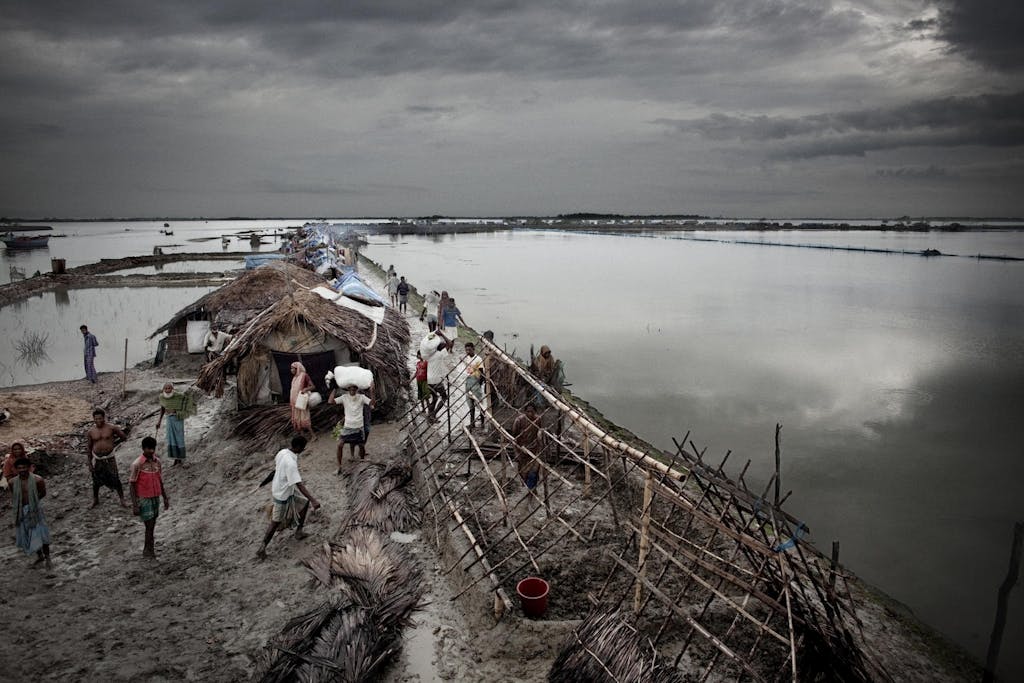2020 caught everyone off guard. The COVID-19 pandemic upended what was to be a “nature super year,” featuring several much-anticipated and important climate and environment moments and deadlines — from negotiations to reach new targets under the Convention on Biological Diversity to a major UK-hosted Conference of Parties (COP) in Glasgow that would have served as the de facto deadline for countries to increase their 2030 climate goals under the Paris Agreement.
But while international processes were delayed, and even as the damages of the pandemic continue to mount, the end of the year saw a flurry of climate activity that provided a jolt of energy and a foundation on which to build in 2021. Between the UN General Assembly in September and the fifth anniversary of Paris Agreement on Dec. 12, we saw several significant new commitments to climate action from high-emitting countries like China, as well as from leading subnational actors like California — and the election of a new U.S. president who has committed to rejoin the Paris Agreement and restore American climate and environment leadership domestically and internationally.
These recent developments set the stage for the most consequential period for decisive progress on climate and environment since 2015, when both the Paris Agreement and the Sustainable Development Goals (SDGs) were adopted.
At the turn of the year, members of the UN Foundation’s Climate & Environment team turn their respective expertise to seven critical areas:
Climate Diplomacy
While the COVID-19 pandemic severely disrupted the international climate calendar, the year closed with a flurry of important national climate announcements and developments that augur for more success in 2021: the European Union established a target of cutting emissions by 55% by 2030 below 1990 levels; the UK committed to achieve a 68% reduction of greenhouse gas emissions below 1990 levels; China, Japan, and South Korea all announced dates by which they would will achieve net-zero emissions; the Philippines and Pakistan declared moratoria on new coal-fired power plants; and more. A recent Climate Action Tracker update finds that global warming by 2100 could be limited to a 2.1°C increase over preindustrial levels as a result of all the net-zero pledges announced as of November.
What we’re watching for in 2021: Pete Ogden and Ryan Hobert highlight that with the deadline for countries to submit enhanced 2030 climate targets under the Paris Agreement effectively now shifted to 2021, next year will be the time to press the world’s major emitters of greenhouse gas pollution to join the nearly 150 countries that have already enhanced or have committed to enhance their 2030 Nationally Determined Contributions (NDCs). Countries will also need to follow through on their mid-century net-zero emissions commitments — which by early next year will have been set by countries representing 65 percent of global emissions and 70 percent of the world’s economy — to put the world on track for warming of 1.5°C. It is against this backdrop that President-elect Joe Biden, who campaigned and won on an ambitious climate agenda, will rejoin the Paris Agreement and seek to restore U.S. leadership globally.
Climate Science and the Intergovernmental Panel on Climate Change
2020 was another year for deepening the world’s understanding of climate science — and the message is clearer than ever: The time for bold action is now. The Intergovernmental Panel on Climate Change (IPCC) continued to expand on last year’s Special Reports on Climate Change and Land, and the Ocean and Cryosphere, participating in discussions to improve understanding of land and ocean issues within the United Nations Framework Convention on Climate Change (UNFCCC). The World Meteorological Organization ended the year with its annual State of the Global Climate Report, which found that 2020 is on track to be one of the warmest on record, with intensifying wildfires, droughts, storms, and glacier melt. Finally, the United Nations Environment Programme’s Emissions Gap Report found that a green pandemic recovery could cut up to 25% off the emissions we would expect to see in 2030, pointing to a critical opportunity for putting the world on a 1.5°C pathway.
What we’re watching for in 2021: Monica Dean, who leads the UN Foundation’s climate science work, points out that when countries submit their new NDCs, a key benchmark of success will be the extent to which they move into alignment with the IPCC’s Special Report on Global Warming of 1.5°C, which estimated that global emissions need to be reduced by approximately 45% below 2010 levels by 2030 to limit warming to 1.5°C. The IPCC is also expected to release the first part of its Sixth Assessment Report — the Physical Science Basis of Climate Change — in July. This report will show the significant changes our earth system is already experiencing due to increasing temperatures and how our planet is likely to change as temperatures continue to rise.
Climate in Foreign Policy
The need to address climate change within national security and foreign policy was underscored in the work of the Climate in Foreign Policy Project by this year’s converging and overlapping climate-related crises — from locusts and extreme flooding in East Africa to a record-breaking Atlantic hurricane season that wreaked havoc on already struggling parts of Central America. Foreign policy experts are increasingly connecting the dots on ways climate change influences or exacerbates national security threats, including at the UN Security Council and in convenings such as the Munich Security Conference. But there is still work to be done to embed a deep understanding of climate change within foreign policy planning and diplomacy.
What we’re watching for in 2021: The change of administrations in the U.S. provides an opportunity to reinvigorate international climate diplomacy and to reorient foreign policy around an understanding that climate change is a leading national security threat. Additionally, the appointment of former Secretary of State John Kerry to be the first presidential envoy for climate, with a seat on the National Security Council, is a positive step toward integrating climate change into foreign policy decision-making.

Climate Finance
With the COVID-19 pandemic and its associated economic toll, public finance was in high demand for efforts to preserve jobs, halt wealth destruction, and bail out productive sectors. In relation to combating climate change, the key issue this year became whether and how public actors could spur a recovery that would ensure resilience to future economic shocks by “recovering better,” consistent with our collective long-term goal of reaching carbon neutrality.
What we’re watching for in 2021: Attention to a climate-friendly recovery will continue well into 2021 as countries struggle to build greener recovery packages in a world of limited budgetary resources and competing priorities, says UN Foundation international fellow David Levaï. Developed economies will need to demonstrate next year that they are prepared to scale up climate finance in developing economies to meet poorer countries’ mitigation and adaptation needs while not unduly increasing their debt burden.
Nature, Biodiversity, and Oceans
While the “super year for nature” may have been postponed, 2020 still saw significant advancements for nature. More than 60 heads of state signed a Leaders’ Pledge for Nature in advance of the UN Summit on Biodiversity, committing to reverse nature loss by 2030. And the UNFCCC hosted its first Ocean-Climate Dialogue, a step toward ensuring that the ocean is factored fully into climate solutions.
What we’re watching for in 2021: Senior adviser Justin Kenney flags that 2021 will be a decisive year on climate, ocean, and biodiversity, with the actions we take or fail to take determining the future health of our planet for centuries. Most noteworthy will be the 15th meeting of the parties to the Convention on Biological Diversity, where countries are set to agree to new targets to protect and restore biodiversity for the next decade. The new targets are critical for ensuring the protection and health of oceans, land, and all biodiversity.
Food Systems and Climate Change
Hunger and food insecurity have been on the rise in recent years, and these trends will be exacerbated by the impacts of climate change and the economic recession triggered by the COVID-19 pandemic. At the same time, there is growing recognition that reaching net zero is not possible without reducing greenhouse gas emissions from food systems, which account for up to 37% of emissions globally. This year, we have seen bold new proposals that have the potential to catalyze a fundamental shift in food production, including the UK’s agricultural subsidy reform, which will pay farmers to adopt environmentally friendly practices, as well as the European Union’s ongoing efforts to “green” the common agricultural policy.

What we’re watching for in 2021: Ryan Hobert and Evelin Tóth point out that the 2021 UN Food Systems Summit next September offers an opportunity for the global community to reassess the role of food systems in meeting the Sustainable Development Goals and the Paris Agreement. But to ensure that these high-level commitments deliver tangible change on the ground, countries must incorporate agriculture into their NDCs under the Paris Agreement, establish policies that incentivize climate-smart agriculture and reduce food loss and waste, and reorient agricultural subsidies toward support of more sustainable production and nutritious diets. A formal decision on agriculture at COP26 in Glasgow could also help enhance global collaboration and mobilize resources to drive a sustainable, equitable, and climate-resilient food systems transformation.
Subnational Action on Climate
2020 continued the trend over the past four years of enhanced subnational and private sector leadership in the United States. At the state level, the U.S. Climate Alliance — a bipartisan coalition of 25 governors and the governor of Puerto Rico committed to fulfilling the goals of the Paris Agreement, with its secretariat housed at the UN Foundation — continued to blaze a trail for state-level climate leadership, domestically and internationally. The announcement by Gov. Gavin Newsom of California during this year’s UN General Assembly week that the state will end the sale of gas-powered passenger vehicles in the state by 2035 exemplifies the remarkable subnational climate leadership that these actors are taking in their own jurisdictions and on the international stage. The private sector and other subnational city and regional actors also took unprecedented action.
What we’re watching for in 2021: In the United States, subnational actors and the private sector have an opportunity to partner with an incoming administration that intends to prioritize climate change to an unprecedented degree. This will allow for new and innovative activities and modes of collaboration, both at the domestic and international levels, including, significantly, around the development and delivery of a U.S. 2030 Nationally Determined Contribution.
Turning the pandemic response into an opportunity for climate action
Of course, all of this encouraging activity comes in the context of COVID-19 and is shaped by the world’s response to the pandemic, which offers us a unique chance to chart a new collective climate course. The impact of the pandemic and the world’s response to its economic and social repercussions are now interwoven with the climate crisis, magnifying its urgency while also creating new conditions that could enable us to meet it. The direction and nature of the global economic recovery from the devastation of COVID-19 will be decided over the next year by large-scale response and recovery packages that are being developed and implemented by governments and international financial institutions. If designed and implemented properly, these investments can and must fundamentally reorient the trajectory of the global economy toward clean, sustainable growth. This may prove to be the world’s most important 2021 climate test.



 View All Blog Posts
View All Blog Posts




